
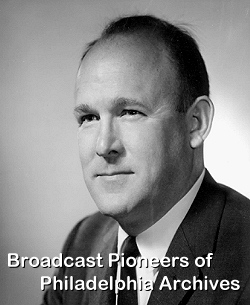
Keneth Alden Simons was born on Monday, March 10, 1913 in Philadelphia and grew up in Bryn Athyn. By the way, that is not a typo. Keneth spelled his name with only one N. While Simons was well known for his pioneering and major contributions to the development of the cable TV business in America, those of us here in Philadelphia will also find his early career very interesting.
Keneth recorded some cassettes telling his life story to his family. Well, one of Keneth's daughters, Dona (spelled with only one N) sent us this quote from one of those tapes. He said: " In the summer before I went to college, I got a job running a little radio station in Elkins Park, WIBG, and every morning I would take my bicycle over to Elkins Park. It really was rather fun."
Simons, an amateur radio enthusiast, was a transmitter operator for WIBG. He worked for twelve cents per hour. The station was originally started and owned by a church, St. Paul's Episcopal Church. At the time, Simons worked there, the transmitter and studio were in the basement of the church.
A neighbor got him in at the RCA Plant in Camden as a stock boy. However, he didn't keep that job for long. His boss "fired" him and gave him a promotion as a test equipment designer.
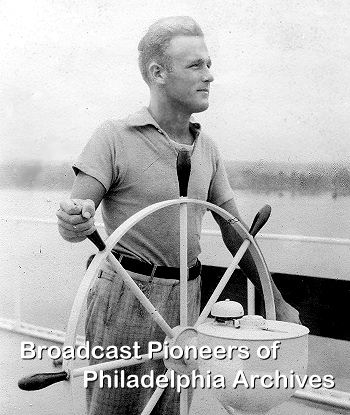
Ken Simons sailing off the coast of Cuba
1937
Then in mid-1930s, he got a job as a summer relief studio operator for WCAU Radio. He did a lot of big band broadcasts. Some were aired locally and some went out over the network (CBS). Remember that the Levys owned WCAU with the Paley family owning a third of the stock. Bill Paley and his family owned CBS. Bill's sister was married to Leon Levy and both Leon and Ike Levy were on the board of directors of the network.
One time, Simons was too shy to ask big star celebrity Gene Krupa for a level (volume check). This was in the days before radio limiters and the volume was way too high and blew the station off the air.
We'll let Simons tell the story in his own words. This is from a recording made for his family. He said:
I had my choice of two jobs. I was invited by RCA to come to them as a student engineer in which the position would pay $125 a month. On the other hand, I could be a student relief engineer, studio engineer for WCAU, which was one of the biggest AM stations in town. And they paid $65 a week. Almost double the other offer.
I took the studio job, which turned out to be very interesting. Several interesting things happened. For example, I had, almost every evening, I would go out. I worked the evening shift. Every evening I would go out and put one or another orchestra on the air. Usually local Philadelphia orchestras. On one particular occasion, at the then famous Arcadia Restaurant which was very fancy. And I was to put Gene Krupa on the air.
Well, Gene, as you may know, is famous as a drummer. A former drummer for Benny Goodman. Anyway, I went down and set my equipment up and Gene Krupa came in and I simply was too embarrassed to ask him to give me what is known as an opening level. I was supposed to find out ahead of time what noise he's going to make when he opens.
Well, I learned, because I didn't get an opening level, because when he came on with a tremendous roll of the drums and he put the station off the air because I had my controls set wrong. That was my experience with Gene Krupa.
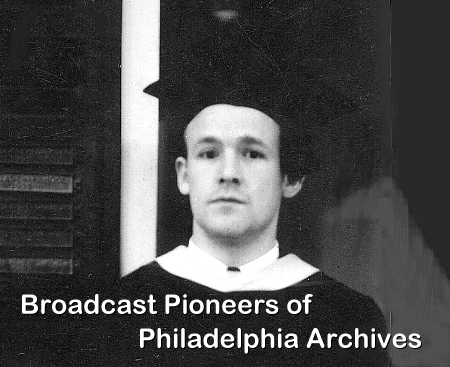
Ken Simons
day of his graduation from the University of Pennsylvania
1938
In 1938, he was graduated from the Moore School of Electrical Engineering. It was part of the University of Pennsylvania and graduated with distinction. He also won a $250 A. Atwater Kent Prize in engineering.
In 1939, he went to RCA as a television field engineer. He helped install the TV exhibit at the New York World's Fair. The next year, during the summer of 1940, recently married Simons was sent by RCA to make recordings and run the public address equipment for the train whistle-stop visits of Republican presidential candidate Wendell Willkie.
In 1941, he went back to work for the Levy Brothers at WCAU Radio here in Philadelphia. This time, he was a general engineer who dealt with installing transmitters and designing studio layouts. Simons supervised the installation of W69PH. That became WCAU-FM. He also supervised the installation of the console of the 50,000 watt transmitter for the AM station in Moorestown, NJ.
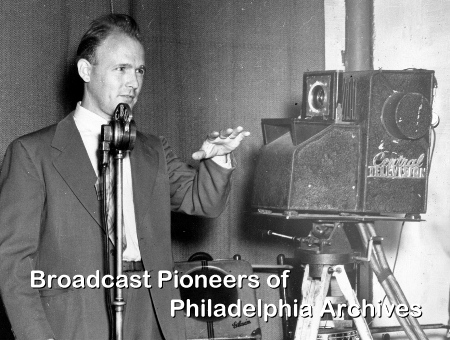
Ken Simons
teaching television production at
The Central Radio School, Kansas City, Missouri
1946
From 1942 until the end of the Second World War, Simons was the Chief Instructor for the RCA Signal Corps School. He also wrote instruction manuals for the war effort.
After the war, he moved to Kansas City, Missouri (1946) where Simons was the Chief TV Instructor for two years at the Central Radio School. From there, he went to Sylvania in Buffalo where he developed TV tuners and the indoor antenna.
In 1951, Keneth Simons starting working for the Jerrold Electronics Corporation, owned by the future Governor of Pennsylvania Milton Jerrold Shapp.
How did he get the job? well, Simons went back to WCAU to see if they could use his services. John Leitch, the station's chief engineer said that they had no openings but referred him to Jerrold.
Simons had his own lab where he worked with other engineers in Bryn Athyn, Pennsylvania, his home town. He was a free-lancer with Jerrold paying him by the week. Several years later, 1955, Jerrold built a new lab in Hatboro, PA. And Ken joined them.
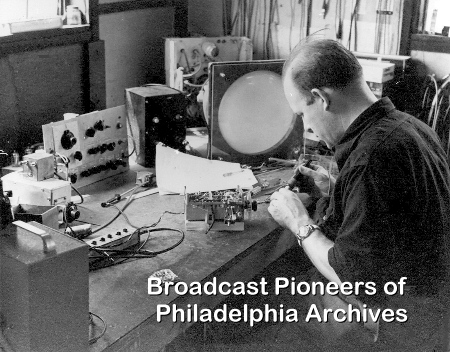
Ken Simons in his own lab
circa 1954
Simons had over a dozen United States and World patents for electrical equipment. He authored four books including his "Technical Handbook for CATV Systems. It went through four different printings.
He was part of the local Operation Moonwatch society, he used an unique tracking system to keep eyes on the Russian space ventures. It was called Doppler.
In 1976, Ken Simons retired from Jerrold and for the next dozen years or so, was a consultant for cable manufacturers. Then he took his consulting skills back to his Alta Mater, the U of P. He passed away on June 11, 2004.
From the official archives of the Broadcast Pioneers of Philadelphia
Written and rearched by Broadcast Historian Gerry Wilkinson
Photos originally donated by Simons family
© 2017, Broadcast Pioneers of Philadelphia
All Rights Reserved
The e-mail address of the Broadcast Pioneers of Philadelphia is pioneers@broadcastpioneers.com